A Perfect 4 Day Yellowstone Itinerary (for First Timers)
There are parts of Yellowstone National Park that make you feel like you’re on another planet. Bright blue-green thermal pools. Towering geyser eruptions. And herds of bison that we’re convinced are at least part alien.
It was our first stop on a big road trip that included Yellowstone and Grand Teton in Wyoming, then took us down to Colorado and Rocky Mountain National Park, and back home through the Utah National Parks.
After a summer spent in Washington State and Oregon, Yellowstone was a stunning departure from our steady summer diet of mountain peaks, alpine lakes, and evergreen trees.
In this itinerary, you’ll find a detailed guide to the best things to do and see, where to stay, travel tips based on our experience, and our take on exactly how to spend 4 days in Yellowstone.
As one of the most popular national parks in the United States you’ll often be sharing some of those sights with hundreds of your new closest friends, but braving the crowds is worth it to see the stunning landscapes that you’ll find in the park.
Plus, if you’re strategic about how you spend your time (SPOILER ALERT: that’s what this guide is for), you’ll be able to avoid most of the crowds.
Planning a trip to Yellowstone? Don’t miss our guide to where to stay in Yellowstone where we dive deep into how to choose the perfect place to stay in the park.
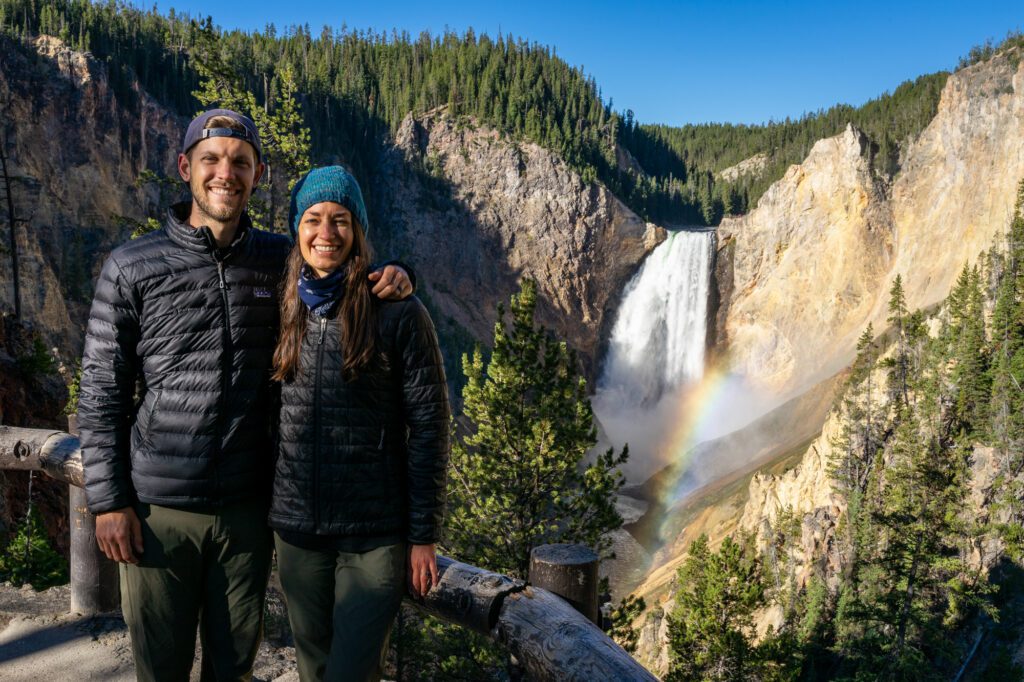
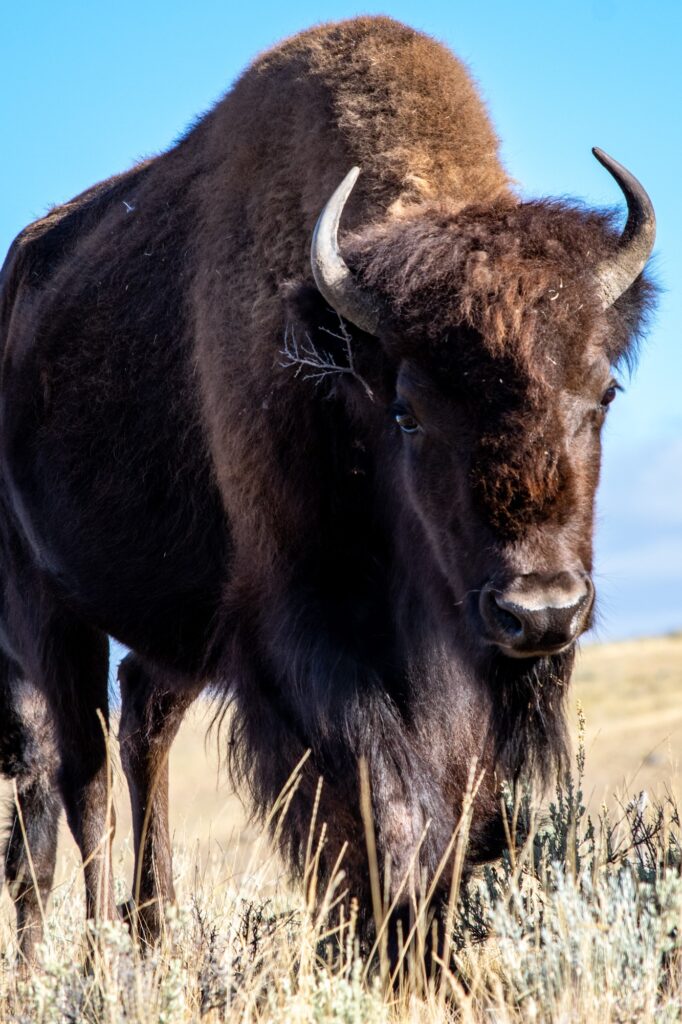
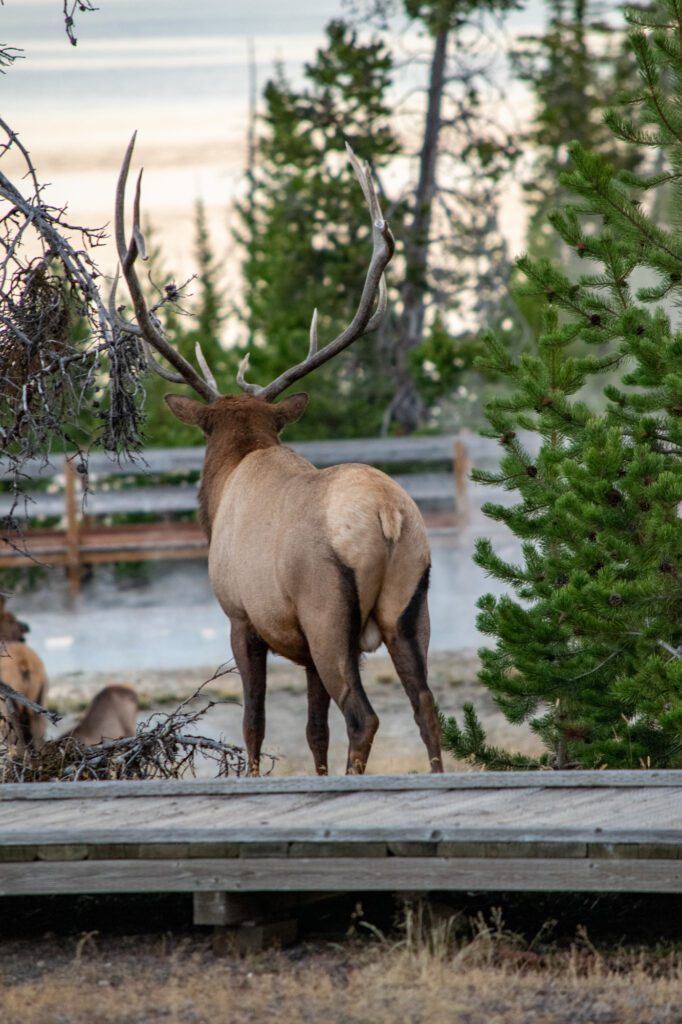
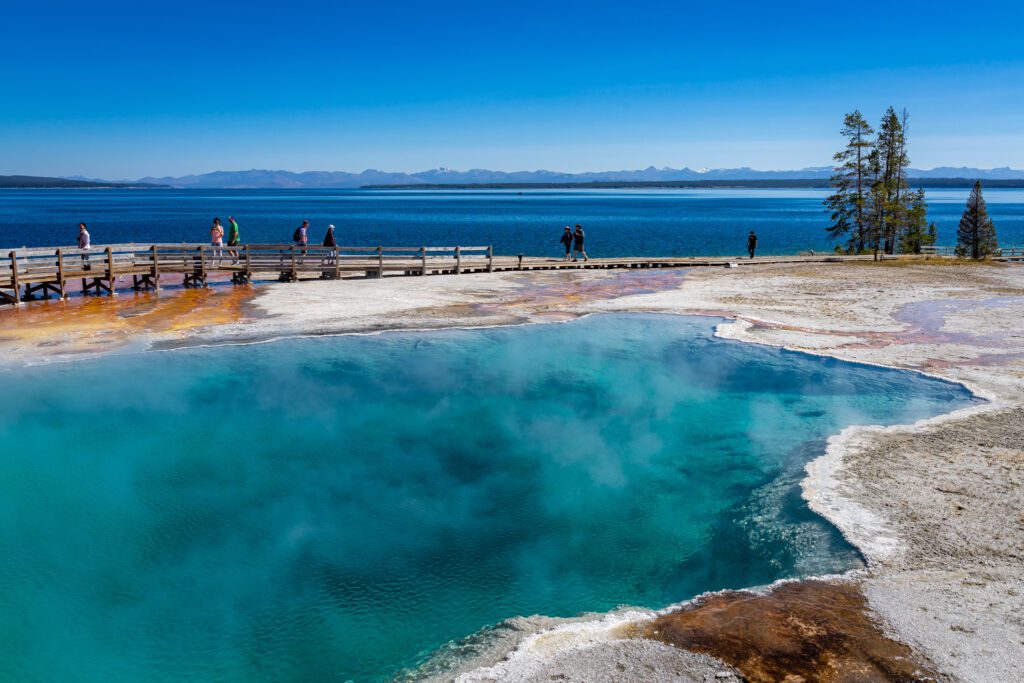
Disclaimer: Some of the links in this post, like hotel links, are affiliate links, meaning at no additional cost to you, we make a little bit of money if you click through and book. That being said, we would never recommend something to you that we don’t stand behind 100%.
How Many Days to Spend in Yellowstone National Park
Before we get to the complete itinerary we promised, let’s quickly talk about logistics. Which are important in Yellowstone National Park because it is enormous.
If you don’t think about how to organize your time, you’re going to spend more time driving, and you’re going to get to see less.
Based on our experience, I would say you need four days at the very least. Five or six would be better, I think, but most people don’t have the luxury of having that much time off.
With four days, you’ll be able to organize your trip with a major activity every morning and evening and avoid the midday rush that happens at all of the big sights in the park.
If you have less than that, we have ideas below the detailed itinerary we’ve written with ways to organize your trip into one, two, or three days.
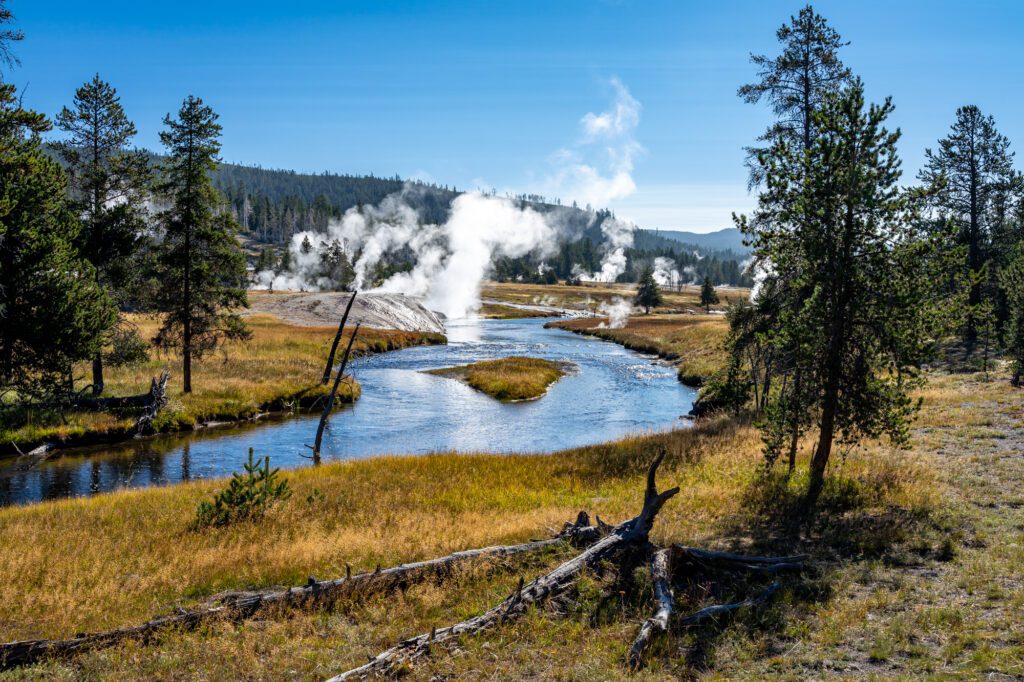
How to Get to Yellowstone National Park
Getting to Yellowstone is a little more tricky than some other national parks. The obvious option is to road trip, which you can do from places like Denver or Salt Lake City fairly easily. We drove from Seattle and spent the night in Missoula, Montana to break up the journey a bit.
If driving isn’t an option, you’ll need to fly into either Jackson, Wyoming, or Bozeman, Montana, and rent a car to drive into Yellowstone.
I wrote this itinerary assuming you’re flying into Bozeman. We drove through Bozeman on our way into the park, and I basically organized the trip the same way we did it.
You’ll start at Mammoth Hot Springs in the northwest corner of the park because that’s closest to Bozeman. It’s roughly an hour and a half from the airport to Mammoth Hot Springs, depending on traffic.
If you fly into Jackson, you should add a stop in Grand Teton National Park on the way to Yellowstone (you’ll want to read our Grand Teton itinerary and our guide to the best hikes in Grand Teton National Park).
Then you’ll enter from the south into Yellowstone, which puts you near the West Thumb Geyser Basin and Old Faithful, so tackle those first and rearrange the itinerary below.
It’s about an hour and a half from Jackson to Yellowstone, not counting a stop in Grand Teton.
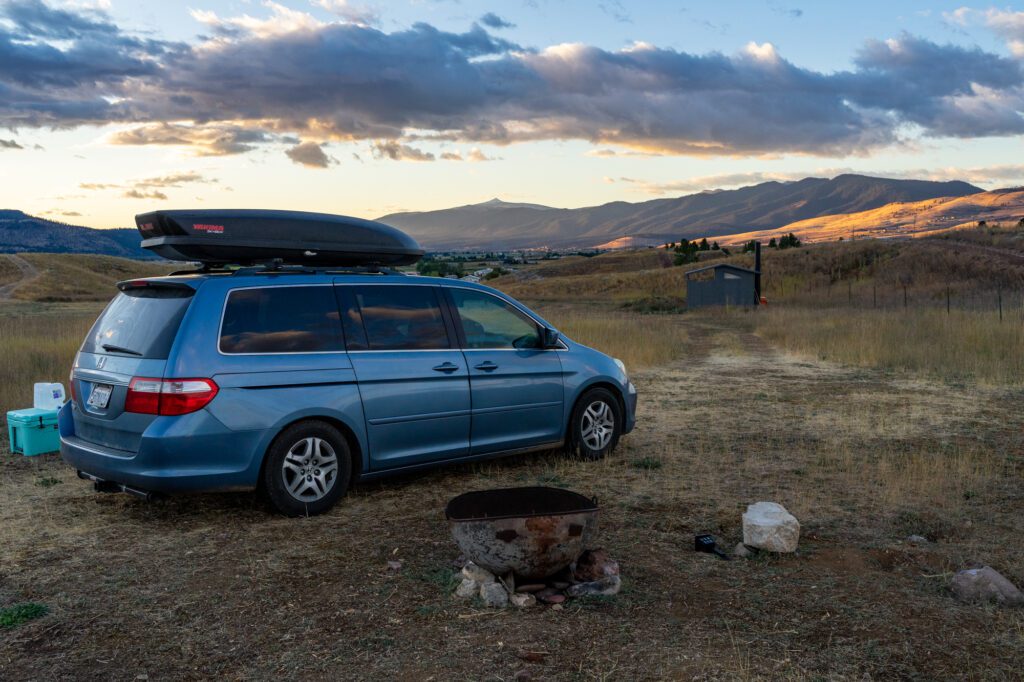
Where to Stay in Yellowstone National Park
This is a pretty complicated question, because first it depends on whether or not you are camping.
Lucky for you, we’ve got a whole guide on the best places to stay in Yellowstone devoted to this exact question. Head over and read that for a deeper dive into how to choose where to stay, or read on for the overview version.
Camping in Yellowstone National Park
If you are planning on camping, you’ll be happy to know that there are 12 campgrounds in the park, and over 2,000 campsites. BUT they are incredibly competitive.
All campgrounds should be reserved in advance (EXCEPT for Mammoth Campground, which is first come, first served in the offseason from October 15 through April 1).
My recommendations are to stay at Canyon for two nights, which puts you in the perfect spot to see the Grand Canyon and Lamar Valley early, when you’ll have the best experience.
Then spend the second two nights at either Grant Village or Madison, which puts you in position for Old Faithful, Grand Prismatic, and the West Thumb.
To have even a remote chance of getting a reservation, you’ll need to either:
- Make reservations as far in advance as possible – at least six months in advance, even more if you’re planning a summer trip.
- Hit refresh on campsite availability a few times a day to check for cancellations, which is how we got our sites at Canyon and Grant Village.
Lodging Inside Yellowstone National Park
If you’re not into camping, you only have a few options inside the park, and that’s the historic park lodges.
While these places are gorgeous and the location couldn’t be better (it’s going to save you A LOT of time to not have to drive in and out of the park every day), you’re going to pay extra for the convenience and location.
The other thing to know is that they book up FAST. And there’s a very limited supply of rooms.
As far as logistics go, you should try to spend two nights at Mammoth Hot Springs, which will put you in the perfect position to explore Mammoth Hot Springs and the Lamar Valley (alternative: Canyon Lodge), and then two nights at the INCREDIBLE Old Faithful Inn (alternative: Old Faithful Lodge).
That way you’ll be well-situated to get to Mammoth, the Grand Canyon of the Yellowstone, and the Lamar Valley from Mammoth Hot Springs, then Old Faithful and the West Thumb from Old Faithful Inn.
Lodging Outside of Yellowstone National Park
If you’re on more of a budget or the lodges are all booked up, you’ve got a few options.
Following the same principle of spending two nights close to the Lamar Valley and Grand Canyon, and two nights close to Old Faithful and the geysers, you should book your first two nights in Gardiner, MT and the last two nights in West Yellowstone.
Staying in Gardiner, Montana
From Gardiner, it’s an hour to the Grand Canyon of the Yellowstone and the Lamar Valley, and only 22 minutes to Mammoth Hot Spring.
Gardiner has a nearly unlimited number of hotel options for you to choose from. We think you should look at the Yellowstone Gateway Inn and the Yellowstone Riverside Cottages.
The Yellowstone Gateway Inn has hotel-style rooms with rustic décor, but the real star of the show is the suites, which are basically apartments with full kitchens and plenty of space for you whether you’re a traveling couple, or you’re planning a family reunion in Yellowstone.
Plus, it’s quite literally right outside the north entrance to the park. It’ll make a great home base for exploring Yellowstone.
The Yellowstone Riverside Cottages are in a similar location, just a couple of minutes outside the park entrance, and have a wide range of room sizes, configurations, and styles to choose from.
Opt for a rustic private cottage, which has enough space for a couple or small group (most have kitchens), or a more modern suite.
They have options for couples and groups of four to six. Some rooms – particularly the suites – have views of the Yellowstone River from a private balcony.
There are a bunch of vacation rentals in Gardiner too, most are clustered along the river and in the same corridor as a hotel.
Keep in mind that, these days, vacation rentals are often either the same price or more expensive than hotels thanks to the cleaning fees, and are far less flexible.
Couples should look at this cute and cozy cottage, which has everything you’ll need for exploring Yellowstone in a great location, or this modern cabin that is just blocks away from the park entrance.
If you’re traveling with a group, consider this little castle, which sleeps 10 and has plenty of common space for the whole group, or this spacious home that sleeps 11 and has great views from the private deck.
Staying in West Yellowstone, Idaho
From West Yellowstone, it’s only 50 minutes to Old Faithful, which is a great location for exploring the southern half of the park. The town has plenty of amenities – food, restaurants, gas stations, and more.
In West Yellowstone, the best places to stay are:
- Hotels: The gorgeous Adventure Inn and the 1872 Inn (adults only – great spot for couples in Yellowstone!) are at the top of my list for next time I’m in Yellowstone. Families or groups should consider the Kelly Inn West Yellowstone, which has family rooms with bunk beds, or the Faithful Street Inn, which has full houses with options that have two and three bedrooms – perfect for groups who need a little extra space.
- Vacation Rentals: Couples, consider this private one bedroom cabin or this rustic log cabin in town. Families and groups, look at this two bedroom cabin (sleeps four) or this newly constructed cabin (also sleeps four).
Tips for Planning Your Trip to Yellowstone
Here are some tips that are based on our experience in Yellowstone National Park, which was in early fall.
- How to Respect the “Locals”: In Yellowstone, there is an incredible abundance of wildlife literally everywhere. Elk, bison, grizzlies, some wolves, and even moose! Remember – they are WILD ANIMALS. Stay at least 25 yards away from elk and bison, and 100+ yards away from grizzlies and wolves.
- Where to Find Wildlife: The two best spots in the park for wildlife spotting are the Lamar Valley (great for wolves, bison, and occasionally grizzlies) and the Hayden Valley (SO MANY BISON). The best time to see wildlife is within an hour of sunrise and sunset. We did a nightly “game drive” every evening, and went out to the Lamar Valley at 5:00 am (it was literally 16 degrees F) to spot wolves. Butttttt….
- BRING BINOCULARS: There were wolves in the Lamar Valley, but all I had was my zoom lens on my camera and we weren’t able to actually see them. If you want to see wildlife, you should invest in a quality pair of binoculars before your trip. My mom went to Yellowstone a few weeks after we did and I told her to buy binoculars. Guess what? She saw both wolves and grizzlies, which we missed. I’m DEFINITELY not bitter about that though.
- Avoiding Crowds: The crowds in Yellowstone are insane. And it doesn’t help that everything is within a few hundred yards of a parking lot. I would plan on an early morning outing, a leisurely lunch, and then a late afternoon activity. Going to any of the main sights between 11:00 am and 3:00 pm is a fool’s errand – you’ll end up spending more time waiting for parking than seeing the sights. Plus, a side bonus, the light will be better for pictures.
- Time of Day Considerations: The pools in Yellowstone are one of the highlights – how the heck are they that color? Early and late in the day, which is when I JUST told you to go see them, they are going to be less vibrant because the sunlight really brings out the colors, but there is a cool steam effect that happens when the hot steam hits the cool air. Midday is when they really shine (see below for the same pool at different times of day) but the crowds are borderline unbearable.
- Remember the Elevation: Yellowstone is pretty high up, around 8,000 feet, which I didn’t quite realize. Take it easy on your first day to acclimate, and drink plenty of water to stay hydrated.
Remember, Yellowstone National Park is enormous – one of the biggest national parks in the country, in fact. The drive times to get from point A to point B was most surprising to us.
For example, because Grand Loop Road connecting Canyon Campground and Tower Junction was closed, it took us TWO HOURS to get to the Lamar Valley. One way. We left at 4:00 am to make it there for dawn.
Pssst! This itinerary pairs VERY nicely with this 3 Day Grand Teton Itinerary to complete a 7 day loop through two of the best national parks in the United States.
An Incredible 4 Day Yellowstone National Park Itinerary
Now that you’re prepared with all the logistics to help you make the most of your time, onto the actual itinerary and exactly what to do in Yellowstone.
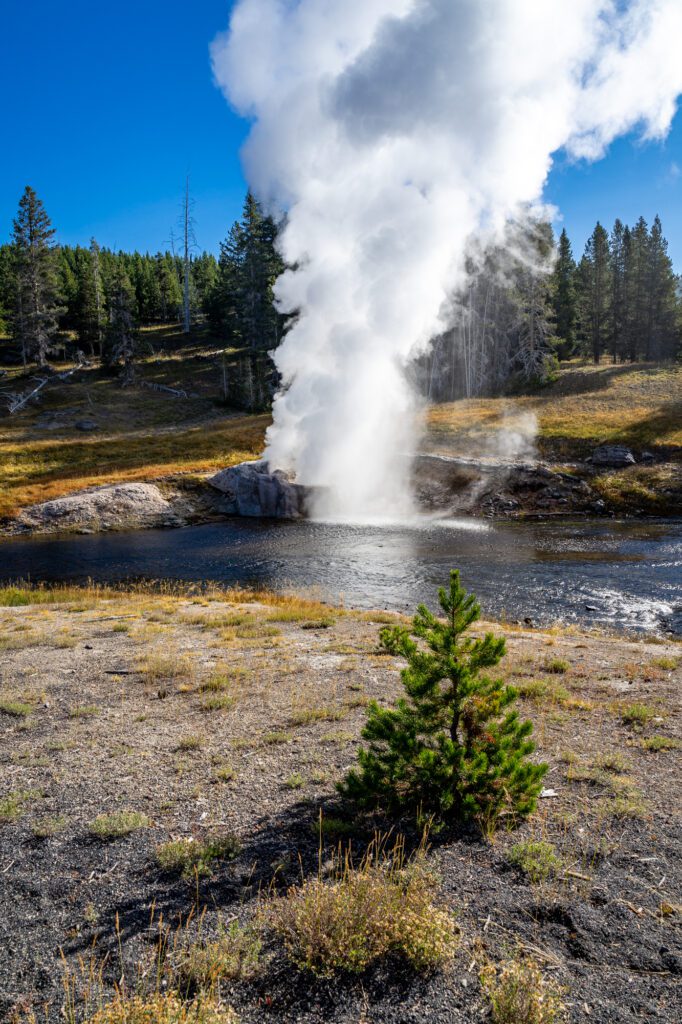
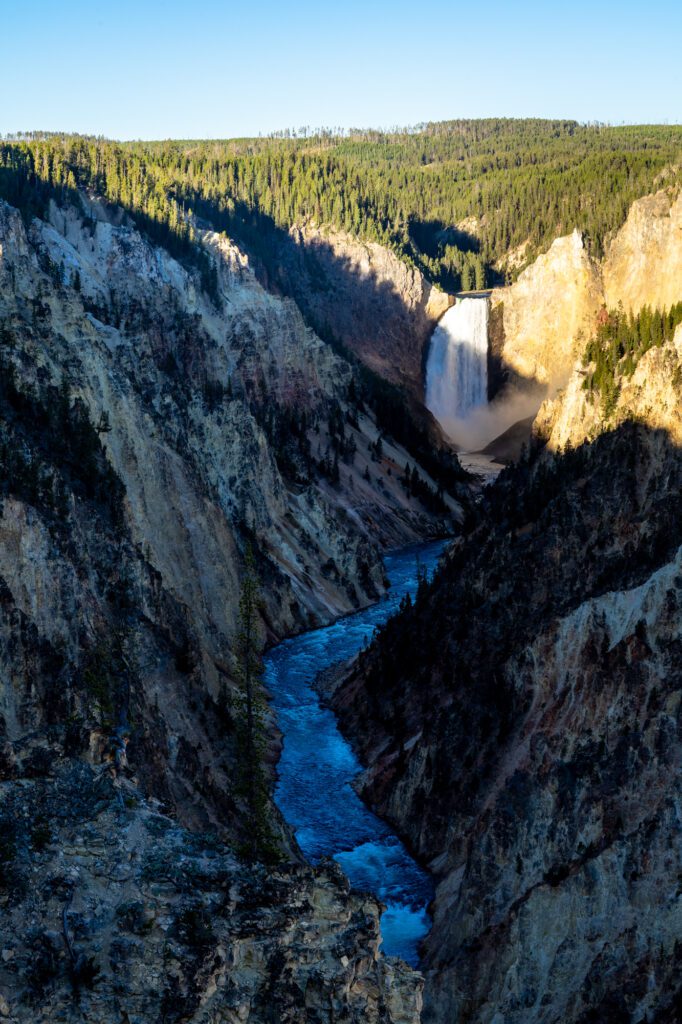
The Best Things to Do in Yellowstone – DO NOT MISS THESE
There are five things that you should make sure you hit on your trip to Yellowstone. You’ll find them, in more detail, in the guide below.
- Old Faithful Eruption: There are signs outside the Visitors Center that will tell you when the next eruption is predicted. It’s a prediction, so it’s not always 100% accurate, but I think the ranger said they are about 90% accurate to 10 minutes on either side of the prediction. Make sure to go up to the viewpoint on the hill to view it – it’s more impressive, I think, when you have a sense of the scale and see it towering over the Old Faithful Inn.
- Grand Prismatic Hot Spring: So many colors! Head up to the overlook along the Fairy Falls Trail for the postcard-perfect view.
- The Lamar Valley at Sunrise / Sunset: Sure, it’s a little bit of a trek, but the payoff is worth it. Where else are you going to see wolves in the wild?
- The West Thumb Geyser Basin: The underrated hero of our trip, we loved it so much we went back twice.
- Grand Canyon of the Yellowstone: Another unsung hero – make sure you’re there around 9:00 or 10:00 am, when the rainbow shows up and the rising sun lights up all the colors of the canyon.
Now, onto how to fit all of those things in over the course of your time in Yellowstone.
You’ll essentially be making your way from north to south through the park. This means you’ll be saving two of our favorite sights – Grand Prismatic and Old Faithful and geyser walk – for last.
Here’s what the detailed itinerary below looks like when broken out by day.
- Day 1: Mammoth Hot Springs and the Hayden Valley
- Day 2: The Lamar Valley, a Hike, and Geysers at Golden Hour
- Day 3: The Grand Canyon of the Yellowstone, Yellowstone Lake, and the West Thumb Geyser Basin
- Day 4: Old Faithful, Grand Prismatic Hot Spring, and ALL of the Geysers
Day 1: Mammoth Hot Springs and the Hayden Valley
Today, you’ll arrive in Yellowstone with about half a day to work with. Head straight to Mammoth Hot Springs to see one of the most unique geothermal features in the park, then move on to the Hayden Valley at sunset.
Where to Stay: Canyon Village (Campground or Lodge) or Gardiner, MT.
Arrival and Mammoth Hot Spring
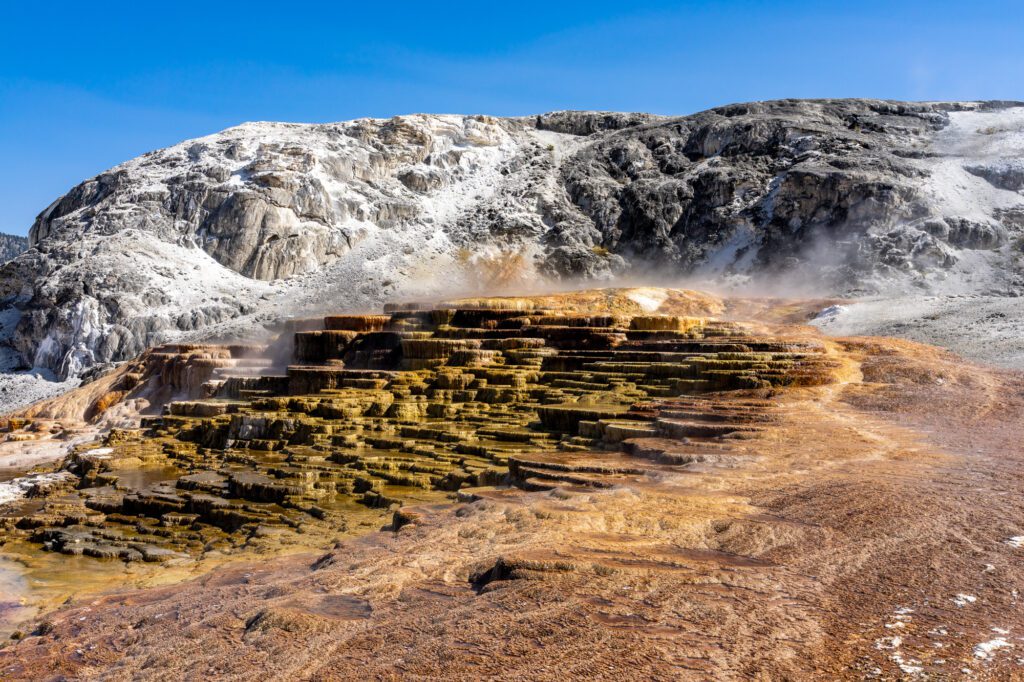
Whether you’re driving to Yellowstone or flying in from a different state, you probably won’t be arriving in the park until mid-morning at the earliest.
Assuming you’re flying into Bozeman, grab your rental car at the airport and head straight to Mammoth Hot Spring.
Mammoth Hot Spring is a short little boardwalk loop that takes you past a few different geothermal features, but the highlight is the Terraces – a hot spring that looks like something straight out of Alien. It’s one of the most unique features in the park, and it’s an easy loop on the boardwalk.
From there, head to check into your accommodations for the night and get settled in. Have an early dinner and get ready for your sunset safari.
Sunset Drive Through the Hayden Valley
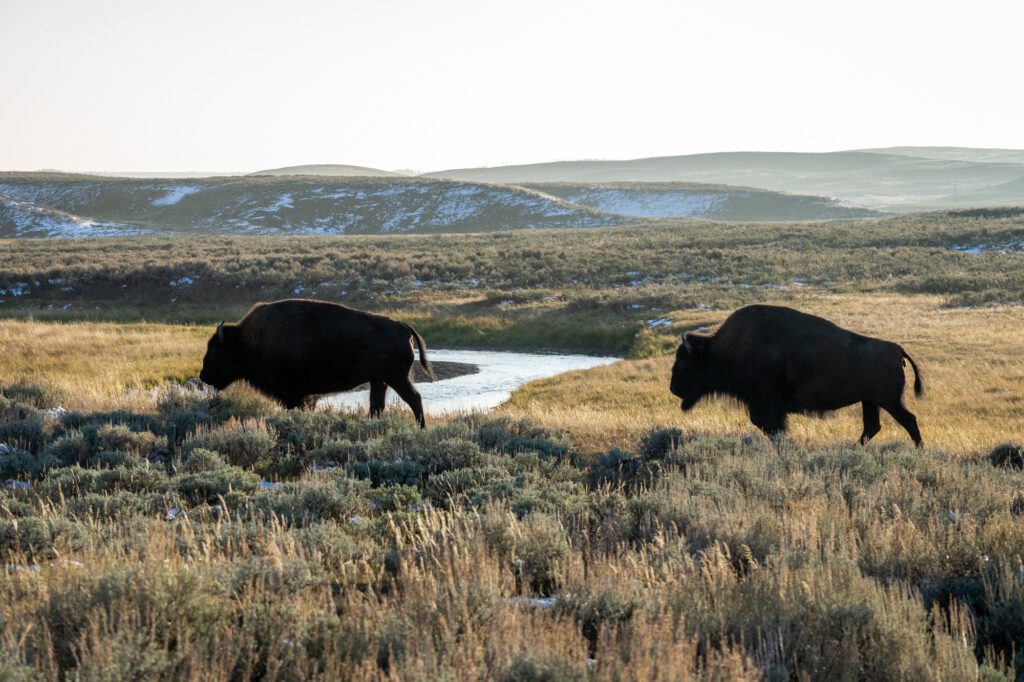
To end your first day on a high note, head out to the Hayden Valley about an hour before sunset to see some wildlife. This is one of the best areas in the park to see bison, elk, and even grizzly bears on occasion. You’ll want to bring your binoculars.
Drive south from Canyon Junction on Grand Loop Road, and eventually you’ll find yourself in the Hayden Valley.
I don’t have a set of stops for you to hit because it totally depends on the day and where the animals are. But if you drive from Canyon Junction down to Sulphur Cauldron and back right around sunset, you’re bound to see a ton of wildlife.
Our strategy was to first, pull over when you see a gaggle of cars, because the paparazzi are there for a reason. Second, we would stop at pullouts with a view and wait for 5-10 minutes to see if we could see any movement.
Other than that, I don’t have much for you here.
There’s more detail on the Lamar Valley, which is your destination tomorrow morning. For now, head home and get some rest. It’s going to be an early morning.
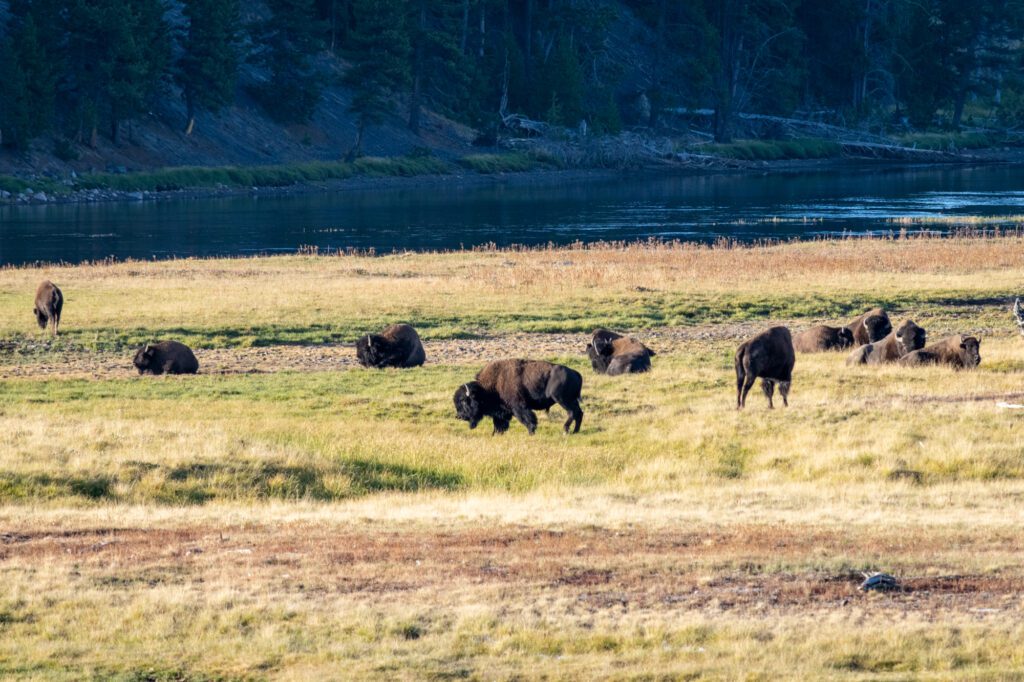
Day 2: Wildlife Safari and Geysers
Today, you’re going to get your best shot to see wolves, and probably grizzly bears too. Note, I’m not saying you’re probably going to see grizzlies, I’m saying this might be your best chance.
Where to Stay: The same place you stayed on the first night – Canyon Village (Campground or Lodge) or Gardiner, MT.
Lamar Valley at Dawn
When I say dawn, I mean dawn. Wolves are most active in the predawn hours, and it’s nearly impossible to see them once the sun comes up and they lay down in the grass to relax in the sun.
You want to be out in the Lamar Valley a full hour before sunrise, which means you need to GET UP EARLY.
Yellowstone is probably the best place to see wolves in the wild. Over time, they have been driven out of their usual land and killed by the ever expanding human footprint that encroaches on their habitat.
The extermination programs that the US sanctioned to protect livestock (among other reasons) certainly didn’t help either.
But in the mid 90’s, 41 wild wolves were released into Yellowstone and the rest is history. Today, there’s about 100 wolves in the park at any given time, and the northern part of the park, including the Lamar Valley, is the best place to see them.
This is a fascinating read about wolves in Yellowstone.
Where to go in the Lamar Valley? It depends. But the best spot we found was right around here.
There was a hill with a bunch of people with fancy spotting scopes looking for wolves. They saw them, we didn’t. Mostly because we didn’t have binoculars.
Obviously that’s not always going to be the best place to see wolves – along the way, look for groups of people up on little hills with spotting scopes throughout the valley.
They’re your best bet for finding where the wolves are hanging out on that particular morning, and they’re usually friendly enough to help you see them too.
A Morning / Afternoon Hike
Next, head back towards Mammoth Hot Springs and head south on Highway 89. There are two hikes in this area that I’d highly recommend, and it depends on what you’re up for.
First is the hike to Bunsen Peak. It’s a 4.5 mile hike up to the top of, you guessed it, Bunsen Peak, which has some nice views over the park.
It climbs 1,300 feet, which is no joke at this elevation, so be prepared to do some huffing and puffing. Try not to blow the house down.
You’ll see signs everywhere that grizzlies have been known to frequent this area, so make sure to stay bear safe – hike in groups, make noise, and carry bear spray and know how to use it.
If you’re up for an adventure, hit the Sepulcher Mountain Trail instead. This is a beast of a hike, but the payoff is some of the best views in the park.
It’s an 11 mile lollipop hike that climbs a whopping 3,400 feet to the peak, which sits at 9,652 feet. If you choose this one, it’s going to take you most of the day.
More Geysers at Golden Hour
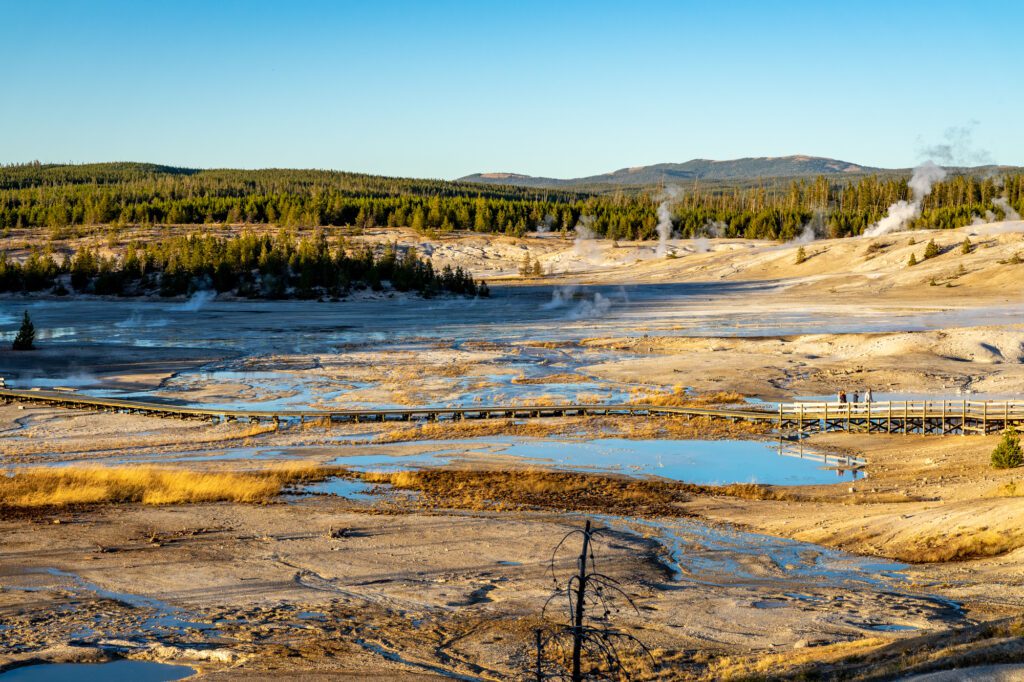
Head over to the Norris Geyser Basin for the late afternoon sun. It’s a 30-40 minute drive from Mammoth Hot Spring, or a 20 minute drive from Canyon Lodge.
The highlight here, at least for us, was Steamboat Geyser, which is the tallest geyser in the world. Unfortunately, it doesn’t erupt all that often (we didn’t see it), but it’s still worth a stop.
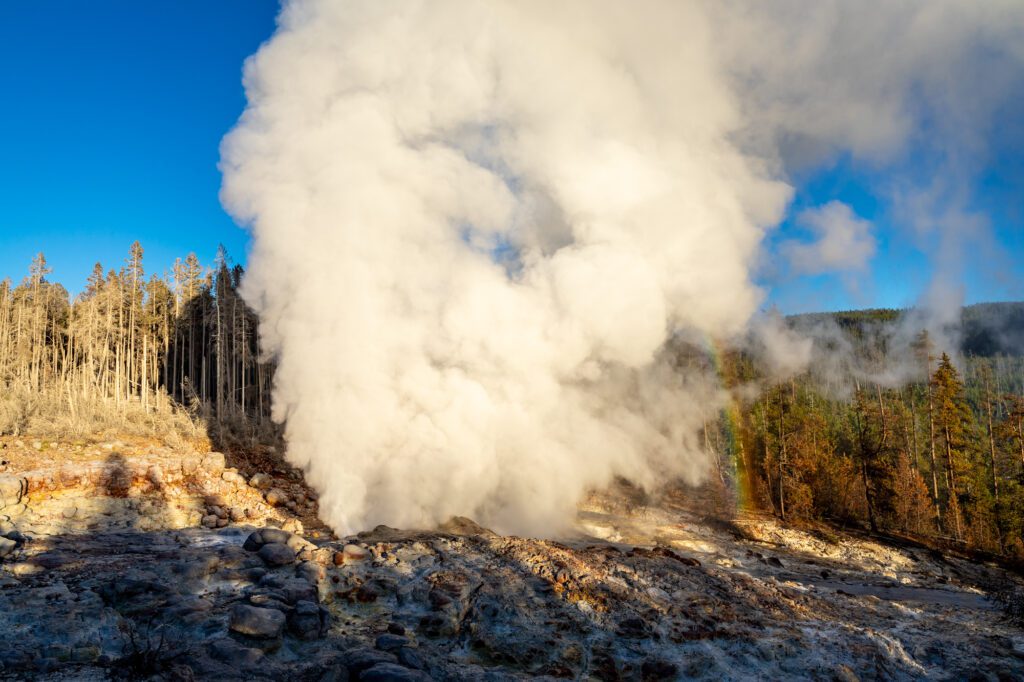
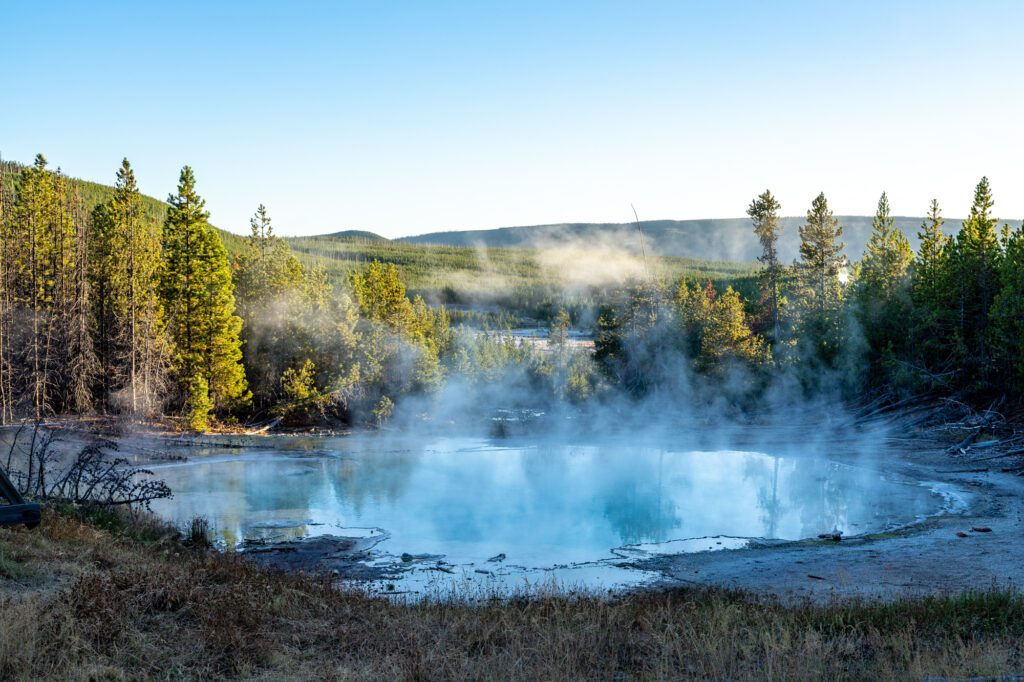
It’s worth doing the entire figure-eight trail to take in all of the natural beauty in both areas, Back Basin and Porcelain Basin. It’s about 2.5 miles all-in and is mostly boardwalk.
Day 3: The Grand Canyon… of the Yellowstone
Today, start with a trip to one of our favorite parts of this entire itinerary: Grand Canyon of the Yellowstone.
Then make your way south through the Hayden Valley, along the lake, and finish with West Geyser Basin, the most underrated sight in Yellowstone.
Where to Stay: You’ll want to check out of your hotel / campground today and move to either Grant Village Campground, Old Faithful Inn, or West Yellowstone, depending on where you chose to stay.
Grand Canyon of the Yellowstone
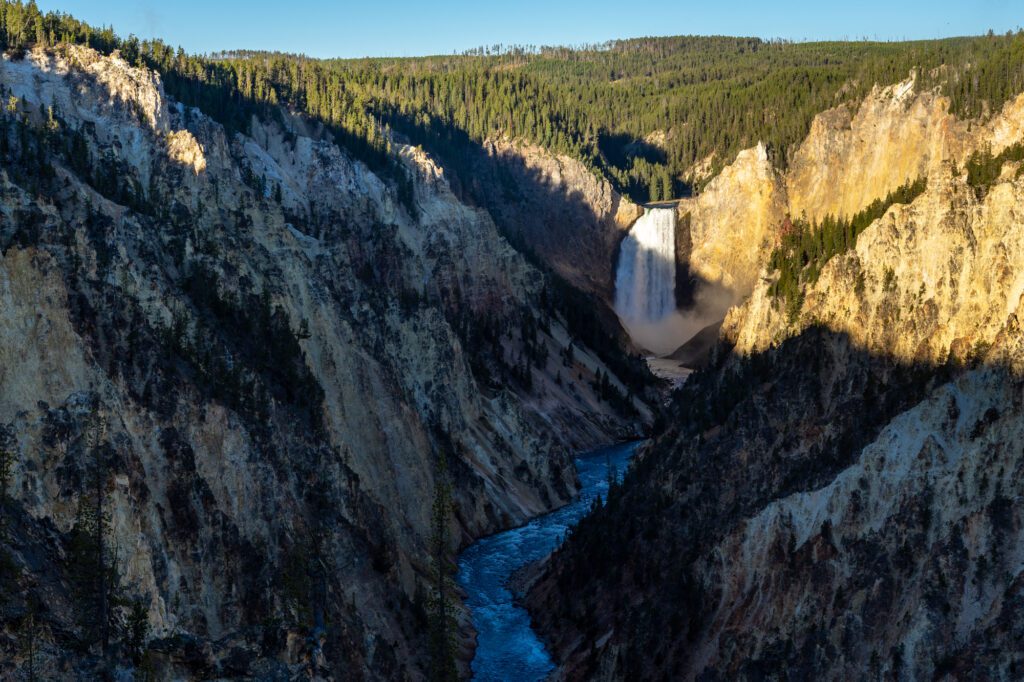
For this area, there are a ton of viewpoints on both the north and south rim of the canyon, and you should do your best to visit them all.
Start on the south side at about 8:30 am and head out to Artist Point, the picture-perfect view of the Canyon and Lower Falls that you didn’t know you needed. Linger here until the rainbow shows up – between 9:00 and 10:00 am, when the sunlight hits the water.
There’s a short hike (2.7 miles round trip) to Point Sublime that leaves from Artist Point. It’s worth doing for more views of the canyon and river, but you lose sight of the falls along the way. We skipped it to spend more time at Artist Point.
Next, head to the other side of the canyon and drive the scenic drive, stopping at all the viewpoints. If you’re short on time, the best viewpoint is definitely the Lower Lookout Point.
It’s a short hike downhill from the parking area (you’ll have to climb back uphill on the way back) but the views are spectacular. You’re a little bit lower, so the view of the falls is straight on. Here are some pictures to show you what to expect.
Finish the scenic loop – you can only drive one way so you don’t really have a choice – and head south on Grand Loop Road through the Hayden Valley, passing herds of bison (but probably not as many as you saw at dusk) before reaching Yellowstone Lake, which makes a great stop for lunch and sightseeing.
Have lunch along the lake (we ate here at a little lakeside picnic area and it was great) and drive out to Gull Point. This scenic offshoot loops back to connect with the main road, so no need to worry about turning around.
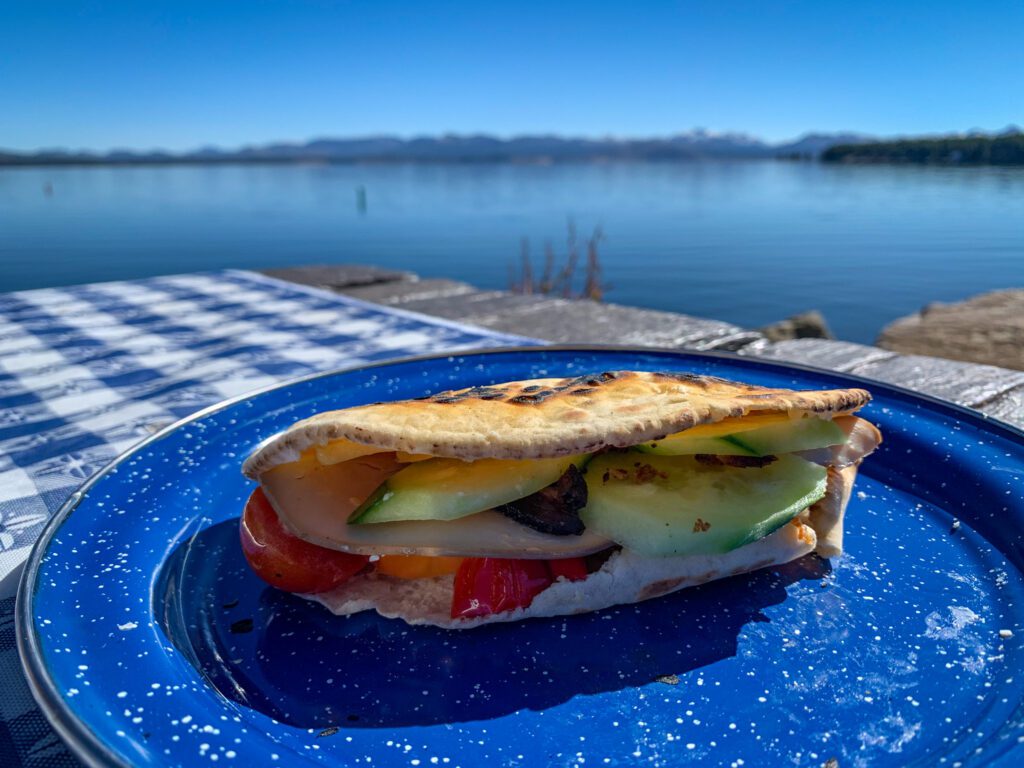
Now that you’re refueled and recharged, tackle an afternoon hike. For scenic views over the lake, make the climb up to Elephant Back Mountain to the overlook at the top.
West Thumb Geyser Basin
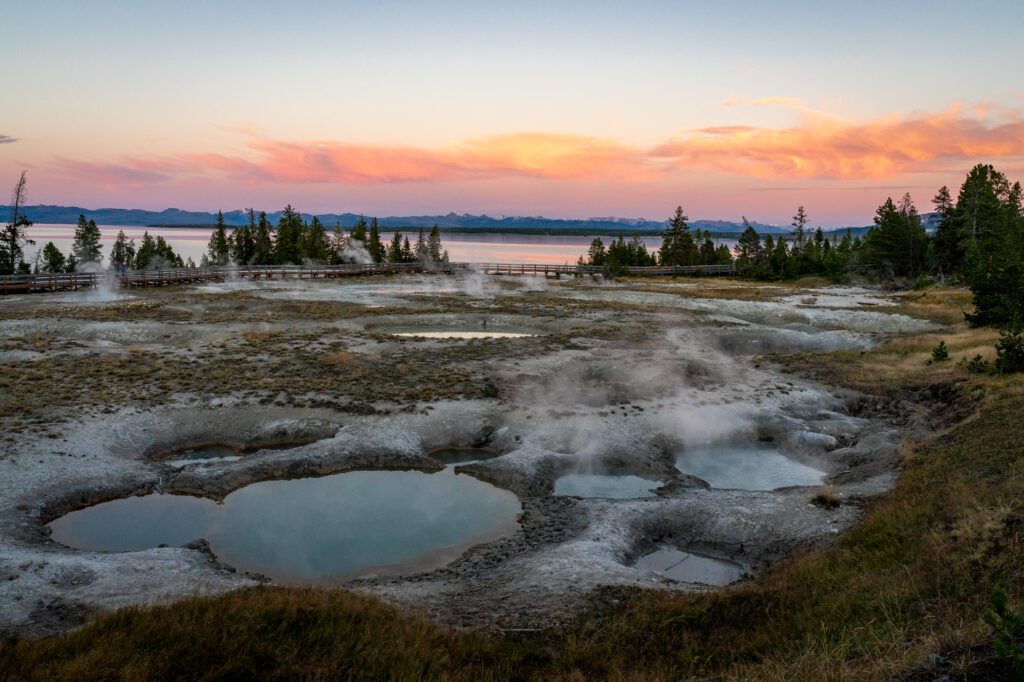
End your day with a trip to one of our favorite spots in the entire park – the West Thumb Geyser Basin. We actually went back twice!
The reason we loved it? Lakeside thermal pools of all shapes, sizes, colors, and bubbliness. AND it’s less visited than just about every other place in Yellowstone.
You’ll want to do the entire loop, starting from the parking lot and heading left at the junction to pass Abyss Pool and Black Pool – two of our favorites of the entire park for the incredible colors.
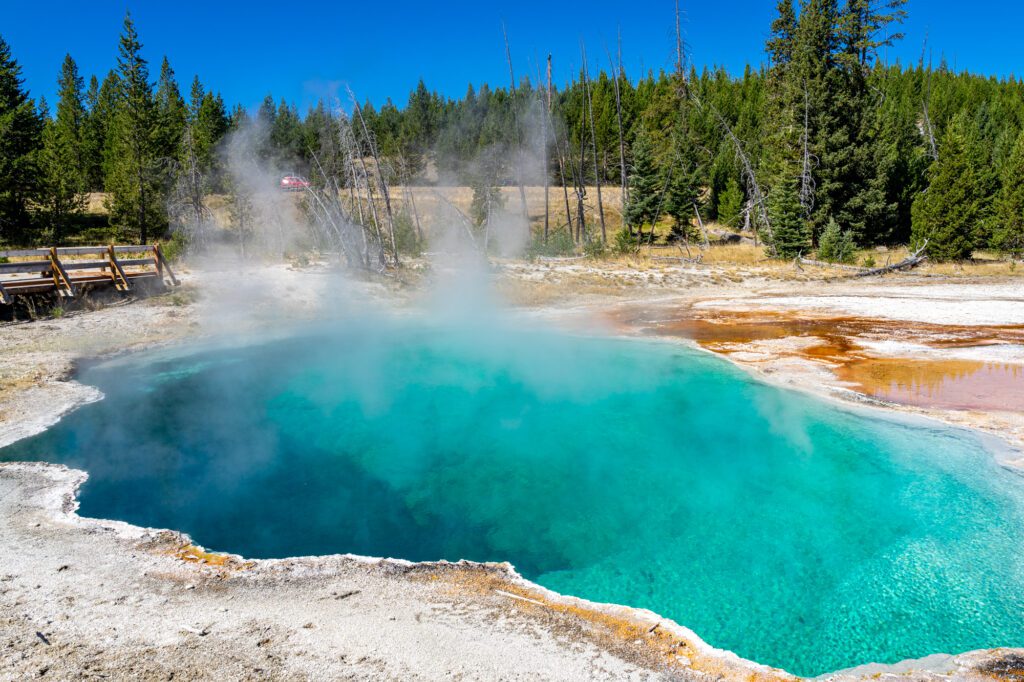
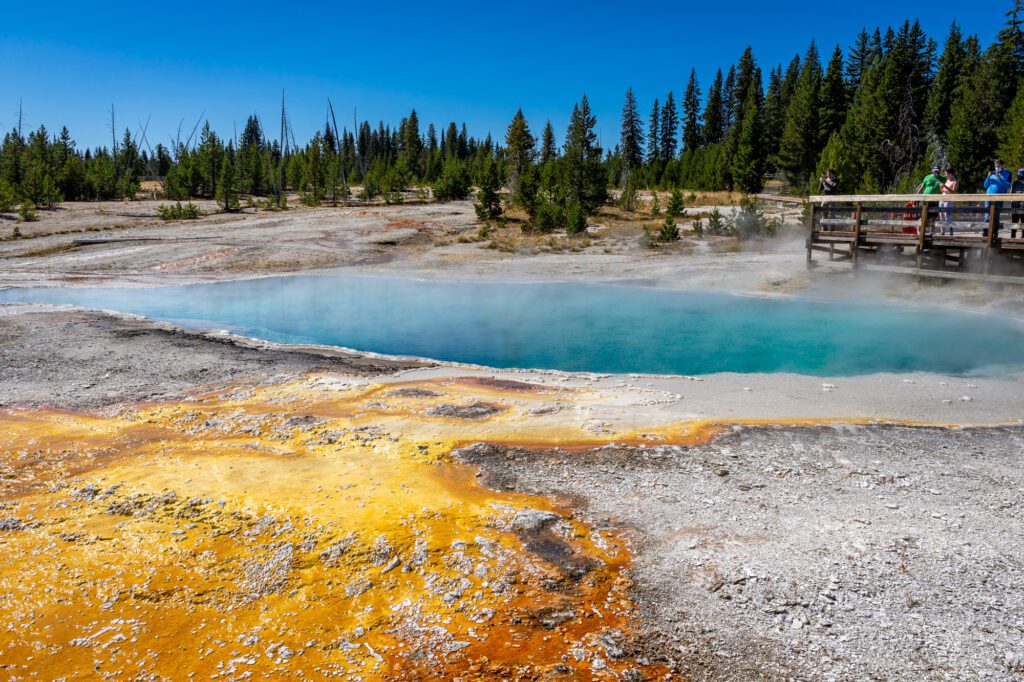
Then make your way along the shore of the lake, making sure to stop at Fishing Cone, a tiny little formation in the lake that bubbles and gurgles.
Except if the sun is high in the sky, you can see in the crystal clear water that it’s not actually a tiny formation, there’s a pretty sizable cone below the water’s surface.
We were in Yellowstone in the fall, which is the dating season for the elk (known as the rut) and saw a big bull elk here with his group of lady elks and some kids.
He was bugling his head off, chasing around the females, while the baby elks pranced around in the middle area between the boardwalks.
It was super cool, I had never heard the part squeak, part scream that is an elk bugling during the rut.
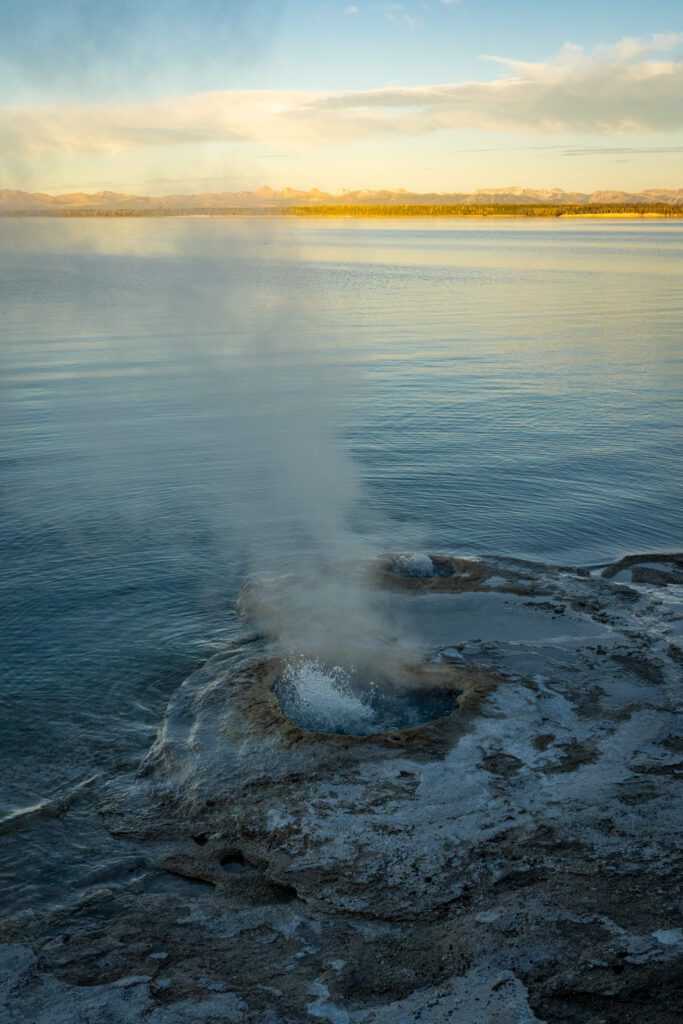
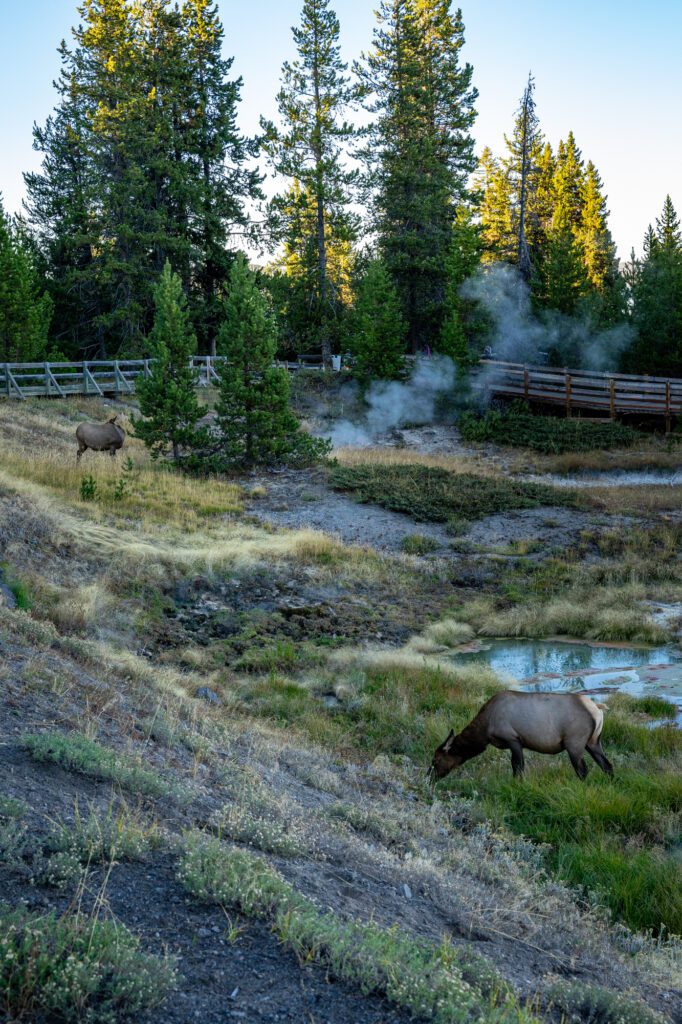
Day 4: Old Faithful and the Upper Geyser Basin
Congratulations! You saved the best for last, and you are in for a treat on the last day of your trip.
You’ll start at Old Faithful, the most famous sight in Yellowstone, move on to the Grand Prismatic Hot Spring, and finish at the Lower Geyser Basin.
Where to Stay: Spend the night in the same place as last night – Grant Village Campground, Old Faithful Inn, or West Yellowstone – before moving on to Grand Teton or heading back to the airport the next day.
Old Faithful and the Upper Geyser Basin
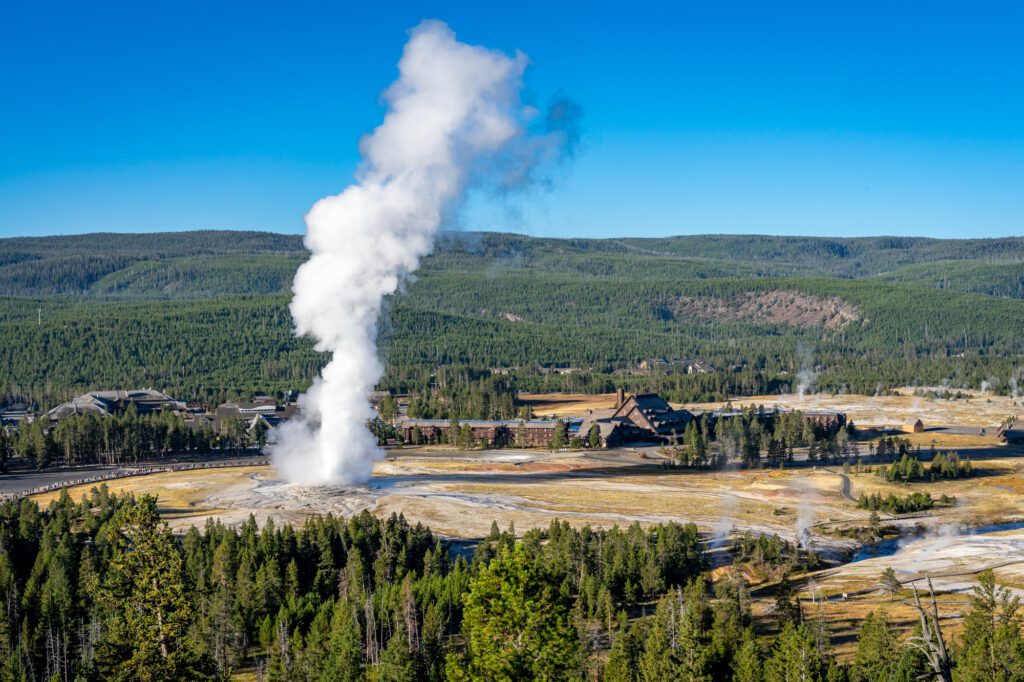
I 1000000% recommend that you visit Old Faithful early in the morning to avoid the crowds, which are INSANE.
Head there first thing, before 8:00 am if possible. When you get there, you’ll see signs for the predicted eruption times around the Visitors Center. It erupts every hour and a half, on average.
If it’s within half an hour of your arrival, you’re in luck! Head up to Observation Point, which is on the opposite side of Old Faithful from the parking area and Visitor Center, and has a view from above that helps give you an idea of the scale of what you’re looking at.
It’s a short uphill hike to get to the viewing area, so plan on it taking 20-30 minutes to get up there.
Once you’re there, relax and enjoy the show.
When Old Faithful is done doing its thing, you should walk the entire Upper Geyser Basin, which is the highest concentration of geysers IN THE WORLD.
Do a self-guided tour that follows the trail from the Observation Point Trailhead, up to Morning Glory Pool with a few pit stops, and back past Castle Geyser and Daisy Geyser.
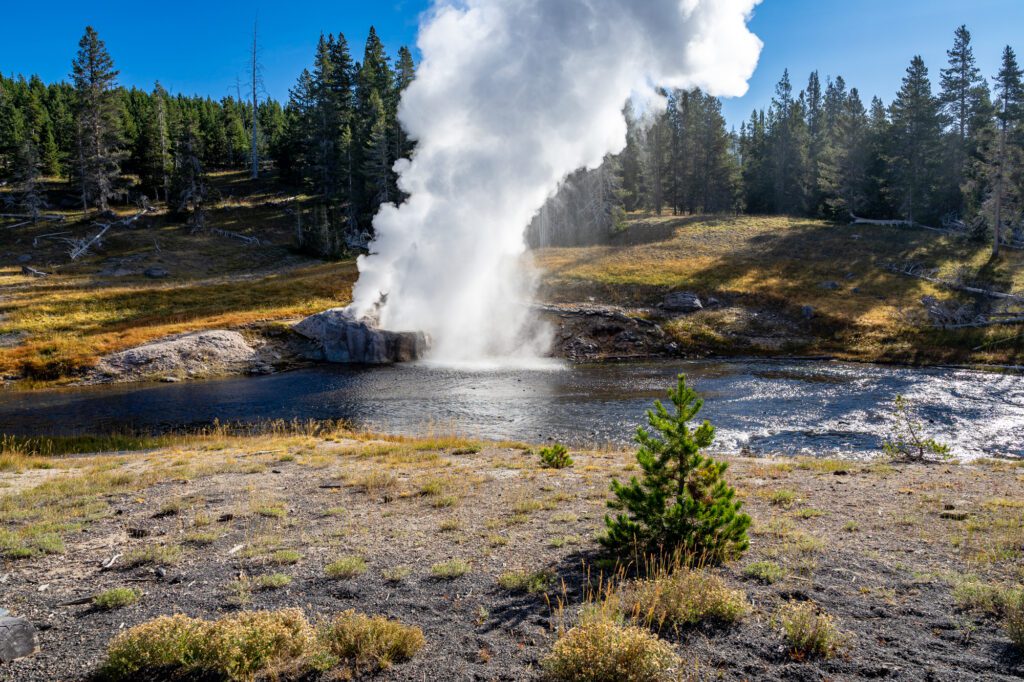
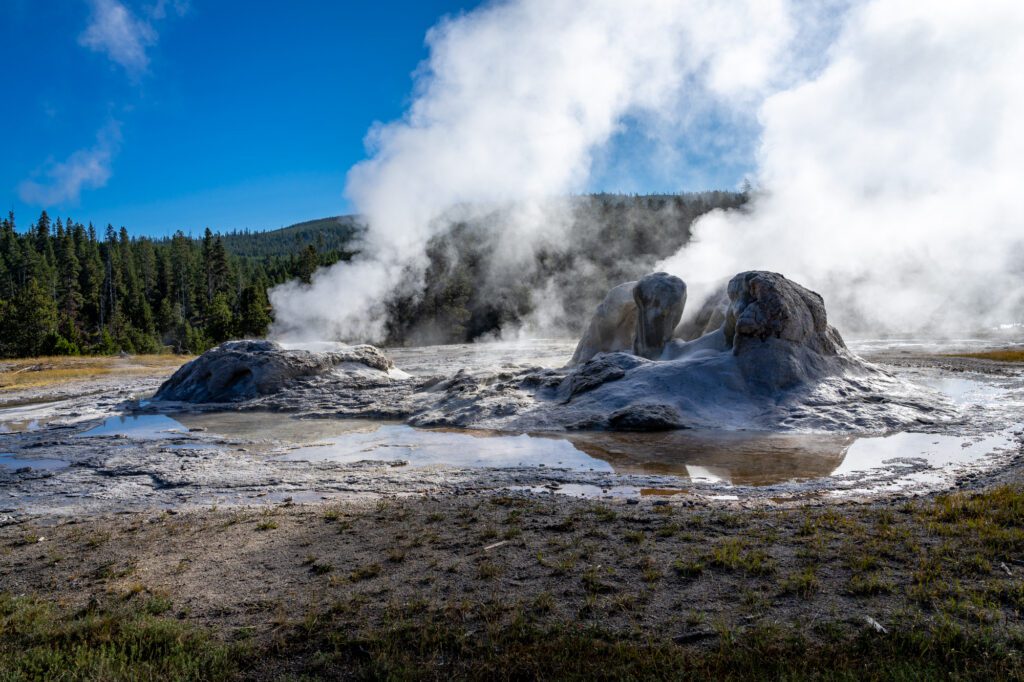
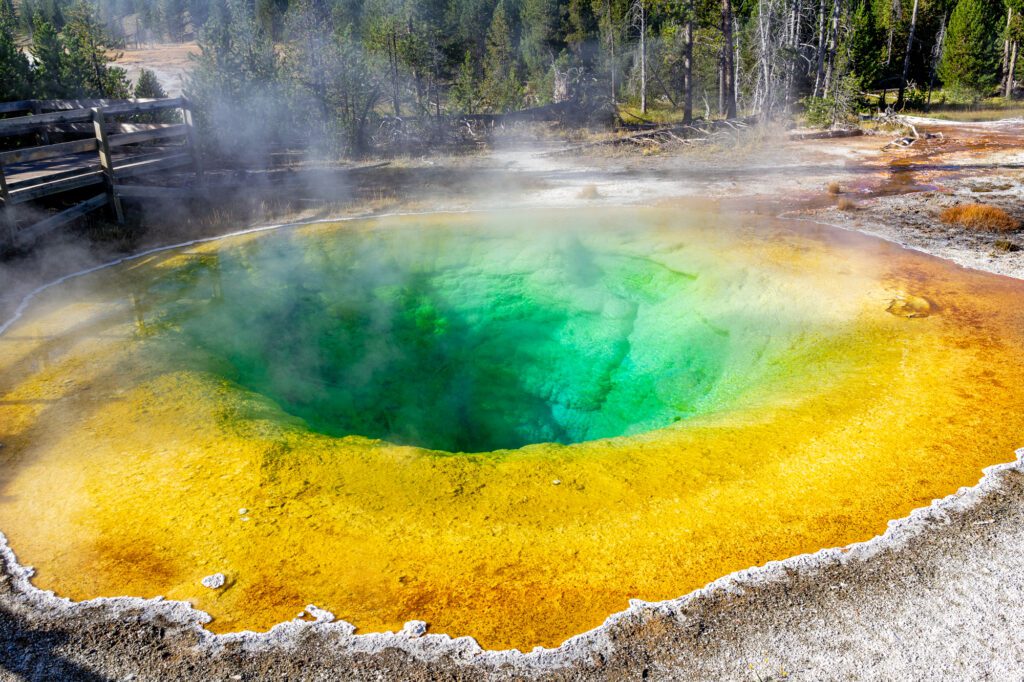
Our favorites were the Chromatic Pool, Grotto Geyser, Riverside Geyser, Castle Geyser, and the stunning green-yellow Morning Glory Pool.
It’s worth stopping at each geyser and learning about what makes them special. Plan on this walk, which is about three miles, taking about an hour and a half.
If you time it right, you can get back to Old Faithful for a second eruption (we did!), which you’ll see from a different perspective.
One thing you can’t really see from above that we noticed from here is all the water that comes spewing out!
Here’s a map of the route, with our favorites plotted along the way.
Grand Prismatic Hot Spring
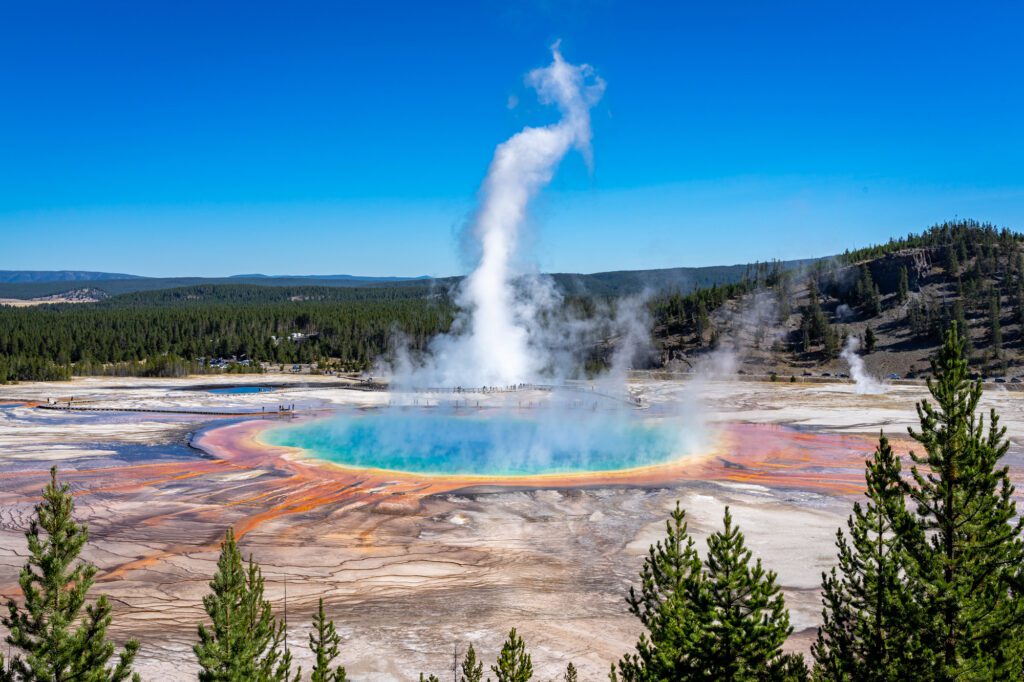
To take in the sheer scale and beauty of Grand Prismatic, head to the Fairy Falls Trailhead to hike to the viewpoint that looks over the vibrant blue/green/orange/yellow (all the colors!) pool.
It’s about a mile and a half there and back with a little bit of climbing to get up above the geyser basin, but it’s worth it for the views.
Then, head to the parking area for Midway Geyser Basin for a closer look at Grand Prismatic. We skipped this part because of the line to park – it was nuts! – but if you can find parking, do it.
Lower Geyser Basin
Finish your tour-de-geysers with a stop at the Lower Geyser Basin, which is confusing, because on a map it’s actually the highest because it’s the furthest north. This area was surprisingly cool.
Visit the bubbling Fountain Paint Pots and walk the entire Fountain Paint Pots loop, which will take you 20-30 minutes. It ends with the shockingly blue Celestine Pool, which is a nice ending point for your journey through Yellowstone’s geysers.
Head back to your accommodations to relax and reminisce about the unforgettable sights, sounds, and smells – because geysers are smelly – you took in over your time in Yellowstone National Park.
What to Do with Less Time in Yellowstone
Have less time in Yellowstone? Here are some ideas on how to experience the best of Yellowstone in fewer days.
How to See Yellowstone National Park in 3 Days
If you only have 3 days in Yellowstone, the first thing we’d do is combine days three and four into one epic day where you hit the Grand Canyon of the Yellowstone in the morning, drive west to hit the geysers (Old Faithful, the Upper Geyser Basin, and Grand Prismatic Hot Spring), and continue southeast to finish your day at the West Thumb Geyser Basin.
This effectively means you’ll have to skip the hike up to Elephant Back Mountain to save time.
For that version of the itinerary, follow days one and two as written above, then combine days three and four in the way that we just outlined.
Here’s what the day-by-day itinerary looks like.
- Day 1: Mammoth Hot Springs and the Hayden Valley
- Day 2: The Lamar Valley, a Hike, and Geysers at Golden Hour
- Day 3: The Grand Canyon of the Yellowstone and ALL of the Geysers
What to Do in Yellowstone in 2 Days
With 2 days in Yellowstone, the simple fact is that you’re not going to be able to see it all. The park is just too big.
One big thing to note here – With just two days, we’d recommend picking one, central place to stay (Canyon is your best bet) and using that as your home base for the entire trip. That way, you don’t have to worry about moving around on different days and can use the entire time to explore the park.
That means you’re going to have to make some cuts to the itinerary above. We’d immediately cut the Norris Geyser Basin and hike from the afternoon of day 2, and the Lower Geyser Basin from day 4.
On your first day in Yellowstone, enter the park from the north and hit Mammoth Hot Springs on the way through, heading towards the Grand Canyon of the Yellowstone. Have lunch, then head out to the Lamar Valley for dusk, which is your chance to spot wolves.
On your second day, follow day 4 of the itinerary above as written for the stops at Old Faithful and the Upper Geyser Basin, then head over to the Grand Prismatic Hot Spring and hike to the overlook.
Have lunch at the West Thumb Geyser Basin, and spend some time on the shore of Yellowstone Lake. Finish your day with a drive back north through the Hayden Valley around sunset for the best chance of seeing wildlife.
Here’s what that looks like in a day-by-day format:
- Day 1: Mammoth Hot Springs, Grand Canyon of the Yellowstone, and Lamar Valley
- Day 2: Old Faithful, Grand Prismatic, the West Thumb, and the Hayden Valley
The Best Way to Spend One Day in Yellowstone
If you only have one day in Yellowstone National Park, you’re going to have to pick and choose what you’re going to see.
Immediately, you’re probably going to have to skip the Lamar Valley just because it is so far from everything else in the park (at least an hour each way to get there and back). The Hayden Valley is a good substitute, but you likely won’t see wolves there.
We’re going to assume you want to see the highlights – Mammoth Hot Springs, the Grand Canyon, and the geysers (Old Faithful and Grand Prismatic).
To combine them all into one long, amazing day, start at the northwest corner of the park and make your way south.
For that reason, we’d recommend staying either in Mammoth Hot Springs, or outside the park in Gardiner, MT for the night before this day.
Get an early start and make a quick stop at Mammoth Hot Springs. Walk the boardwalk and move on – it’s not the most exciting stop of the day.
Next, head over to the Grand Canyon of the Yellowstone, stopping on both sides of the river. Walk to the viewpoint near the parking lot on the south side, and drive the loop on the north side (see above in the detailed itinerary for what stops we liked best).
On to the geysers! Make your way southwest, starting with Grand Prismatic Hot Spring and the short hike to the overlook, and then moving on to Old Faithful. Hike up to the viewpoint for an Old Faithful eruption, and walk the entire loop through the Upper Geyser Basin.
Finish by looping around, driving north along the shore of Yellowstone Lake (not sure you’ll have time for the West Thumb, but add it if you do because it was our favorite!).
You want to be in the Hayden Valley around sunset for the best chance to see herds of elk and bison roaming the golden plains.
It’ll be a whirlwind, but it’ll be an amazing one.
The Best Time to Visit Yellowstone
The best time to visit Yellowstone in terms of both weather and roads being open is the summer – temperatures are high, snow is melted, and the roads are usually completely open, so you’ll be able to see the entire park.
As you probably already expected, the crowds show up in the summer and we found it pretty unbearable.
The parking lots are constantly full, and the fact that everything in Yellowstone is a short stroll from the car means that those trails are PACKED.
Kids being out of school compounds the issue because families take their road trips over the summer, and Yellowstone is a very popular destination.
Fall is the best blend of roads being open, weather, and crowds. Although we were in Yellowstone once in early September just after Labor Day when it was under 20 degrees Fahrenheit and had just snowed.
So the weather is a little more unpredictable, but the upside is that crowds start to thin, and wildlife starts to become a little more active.
The other downside is that parts of the park close in the fall to accommodate high Grizzly Bear activity – particularly the area around Mt. Washburn, which was closed when we were there and meant that the road connecting the Canyon area and the Lamar Valley was closed. Bummer.
In the spring, the snow melts and you’ll start to see wildlife coming out to play, including bear cubs and elk and bison babies.
However, you’re going to have a hard time seeing the park because many roads in the park are closed through April most years. I’d avoid planning a trip to Yellowstone National Park before May.
If you’re visiting Yellowstone in the winter, it’s a veritable winter wonderland. But almost all the roads are closed, and you won’t be able to see much.
Whenever you choose to visit, check road conditions here.
Yellowstone is an incredible example of the natural beauty that exists in the United States. As long as you’re prepared, at times, to share the view with a thousand of your new close friends, you’re going to have an unforgettable time exploring the colorful hot springs, towering geysers, and cacophony of wildlife.
Anyway, enjoy! If you have a full week, this itinerary pairs very nicely with our 3 day Grand Teton Itinerary. We loved Grand Teton, and we saw SEVEN moose! It’s worth a stop, even if you don’t have a full three days.
We also have a Yellowstone and Grand Teton itinerary that combines the two into one epic road trip through two of the best national parks in the United States.

This was super helpful for our visit next year. Thank you for taking to time to really give us a great guide to make the most of our time. What time of year did you guys go out there? We will be heading out for a September trip so that will play a factor.
Thanks again, Greg
Hey Greg!
Thanks for the kind words. Funny enough, we were in Yellowstone in September, and it was magical (except for a bit of snow, which is not ideal if you’re camping). It’s a great time to go because the crowds are just a tiiiiiny bit smaller with kids going back to school. We enjoyed it, and I bet you will too.
Cheers,
Matt
Really enjoyed your piece, Matt. Best must-do itinerary and overview of YP that I’ve come across for a 4 and 3 day itinerary. I’ve sent it to my daughter in law who plans to visit in 2023 (avoiding this anniversary year).
You didn’t mention Tower Falls. The area was closed in 2021 and if that’s when you traveled, I’m guessing that may be why you skipped it. We loved hiking down and around those falls on past trips. And we saw black bears in this area, including a mama with cubs. Twenty five years ago we made our first trip to YP in late May. We camped outside the south entrance. Since that visit we’ve visited 5 more times– in fall and winter. Our favorite time has been May because it was our luckiest time for sighting animals. We’re aren’t dawn people but dusk was lucky for us–and with many folks back at their base prepping or eating dinner, we didn’t suffer big crowds. YP is definitely a magical place. Thanks for writing this excellent highlight and summary article.
Thanks for the kind words, Terry! Yellowstone blew away our expectations, which were already pretty high. I like the idea of visiting in the spring, when it’s going to be less crowded. The crowds were the only thing that we didn’t really like – it felt like every single parking lot and hiking trail was packed to the gills. Thanks for sharing your experience – it makes me want to get back to Yellowstone ASAP!
I think this detail is incorrect. It’s in the section where you talk about going to Hayden valley. ” Drive south from Canyon Junction on Grand Loop Road, and eventually you’ll find yourself in the Lamar Valley.” I believe you meant Hayden valley.
Thanks for your trip detail. I am getting a lot of good information from it.
You’re correct! Thanks for pointing that out – fixed 🙂
Just came back from our snowmobile trip in Yellowstone. We’ve been there about 5 times in the summer taking our grandkids and deciding to finally take a once in a lifetime trip we’ve always wanted to do. Booked an all exclusive package deal. Already had our flight tickets. They provide 4 nights in the lodge, snowmobiles, a guide each day,snow suits , and some free meals. Yes it was cold, -11, -17, but each day what we saw was absolutely beautiful. Buffalo, trumpeter swans,Upper and lower falls, Grand Canyon of the Yellowstone, Old Faithful. Loved every minute!! We were the oldest couple there, 72 and 73. Should have done this years ago lol, but worth every sore muscle ! Oh and no big crowds.
We have friends that have also done Yellowstone in the winter, and it’s on our list (but then again, so is just about every national park, whether we’ve already been or not). Sounds amazing! Especially the no crowds part.
Thank you so much. This is so helpful! We are planning to be there from Sept. 5 to 9 (4 nights). We are staying very close to the north entrance and leave the park on the 5th day from the south entrance because we want to visit Utah. Any advice?
Thanks,
Nalaka
Enjoy your time! My only advice is to be prepared for a LONG drive. We drove to Denver from Teton, and it’s a long, long way with not a whole lot to see along the journey. I imagine it’s similar heading to Utah, though there might be some cool stops along the way (we’ve never done that drive).